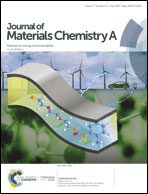Nano-spatially confined and interface-controlled lithiation–delithiation in an in situ formed (SnS–SnS2–S)/FLG composite: a route to an ultrafast and cycle-stable anode for lithium-ion batteries†
Abstract
The exploitation of high-performance anode materials is one of the key challenges for the development of lithium-ion batteries. Herein, we report a micro-nano structured (SnS–SnS2–S)/FLG (few-layer graphene) composite in which the in situ formed SnS, SnS2 and S nanoparticles are tightly supported by the in situ exfoliated FLG. The multi-phase structure could induce the formation of a high fraction of interfaces, enabling the interface-controlled lithiation/delithiation, which is characterized by large interfacial storage and fast interfacial diffusion, and boosting the electrode performance at high rates greatly. On the other hand, the step-wise lithiation/delithiation of S, SnS2 and SnS can offer nano-spatial confinement effects to accommodate the volume expansion and particle aggregation, and thus enhance the structural stability of the electrode. Meanwhile, the FLG matrix can serve as a robust layer to further maintain the structural integrity of the electrode. As an anode for lithium-ion batteries, the composite exhibits an ultrahigh gravimetric/volumetric capacity (1062.2 mA h g−1/2018 mA h cm−3 at 0.2 A g−1), ultrahigh rate (842/756 mA h g−1 even at 5.0/10.0 A g−1) and ultrastable cyclability (100%/93.6% capacity retention after 1000/2000 cycles at 1.0/10.0 A g−1). Even in full-cells and sodium-ion batteries, superb comprehensive performance is demonstrated. Therefore, the (SnS–SnS2–S)/FLG composite could be a new promising anode material for application in batteries.



 Please wait while we load your content...
Please wait while we load your content...